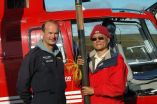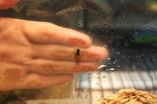(Press-News.org) DURHAM, N.C. – The ability to tell the difference between crystals that formed naturally and those formed by human activity can be important to archaeologists in the field. This can be a crucial bit of information in determining the ancient activities that took place at a site, yet archaeologists often wait for months for the results of laboratory tests.
Now, however, an international team of physicists, archaeologists and materials scientists has developed a process that can tell in a matter of minutes the origin of samples thousands of years old. The new device is easily portable and works by "lifting off" the spectral fingerprint of a material with infrared light.
The first material tested was the mineral calcite, commonly found in rocks such as limestone, which forms over millions years in sediments. These rocks can also contain the mineralized shells of sea creatures. Archaeological sites may also feature calcite that was a part of ash, plaster, or other building materials.
In the latest issue of the journal Advanced Materials, on-line today, Stefano Curtarolo, associate professor of mechanical engineering and materials sciences and physics at Duke University, and Kristin Poduska, associate professor of physics at Memorial University in Newfoundland, and their colleagues at the Weizmann Institute of Science in Israel, describe the new approach, which has already been successfully tested in archeological sites in Israel.
"The key to determining a sample's origin lay in figuring out how well the crystal structure is organized," Curtarolo said. "Naturally occurring calcite crystals are tightly organized, while a material created by humans from calcite is usually far less organized."
However, interpreting the information obtained using traditional methods is time-consuming and tricky, since such factors as particle size and the alignment of the atoms within the crystals can send out conflicting information.
"For this reason, getting useful and reliable information about the sample usually requires careful and time-intensive sample preparation with highly specialized equipment," Poduska said.
The researchers used infrared spectroscopy to take advantage of the fact that different molecular units absorb light differently, yielding distinct spectral peaks, or molecular fingerprints. They put a sample through a series of grindings – sometimes as many as a dozen – while taking detailed infrared spectroscopy readings after each one. By analyzing the absorption peaks at different points in the grinding process, as the particles got smaller and smaller, they could tease out the effects of size and organization.
For example, Curtarolo said, an archaeologist finds a sample and knows that it is calcite, but what cannot be determined at the site is whether it is a naturally occurring mineral, or a building material made of calcite. Plaster is made by heating limestone, grinding it up and mixing it with water.
"We've shown in the field that our method can quickly detect subtle differences in the organization of a crystal by decoupling the two factors that influence the spectral peaks," Poduska said. "Our method is particularly powerful because the direct measurement of particle size is not needed, and it can be used with any crystal that can be excited by infrared light."
Last summer, a team of archaeologists and scientists from the Weizmann Institute successfully tested the new approach at an ancient site in central Israel at Tel Safit, close to where David is thought to have slain Goliath.
"Whenever they found something white, they would call us over to do tests," Poduska said. "We were able to confirm whether the sample was rock or plaster, which helps us decide how to proceed at the excavation site."
INFORMATION:
Other members of the team, from the Weizmann Institute of Science, were structural biologists Steve Weiner and Lia Addadi, nuclear physicist Elisabetta Boaretto, PhD student Lior Regev, and theoretical physicist Leeor Kronik.
The researchers were supported by the Weizmann Institute and the Lize Meitner Minerva Center for Computational Quantum Chemistry and the National Science Foundation.
New technology gives on-site assessments in archaeology
2010-11-18
ELSE PRESS RELEASES FROM THIS DATE:
Novel approach shows promise for cystic fibrosis, say UAB researchers
2010-11-18
Birmingham, Ala. – An investigational drug targeting a defective protein that causes cystic fibrosis has been shown to improve lung function in a small study of CF patients, according to findings published Nov. 18, 2010, in the New England Journal of Medicine. The investigational drug, VX-770, appeared to improve function of what is known as CFTR--the faulty protein responsible for CF. It is among the first compounds being developed for CF that specifically targets the root cause of cystic fibrosis.
Patients who took VX-770 for 28 days showed improvements in several key ...
IQ scores fail to predict academic performance in children with autism
2010-11-18
New data show that many children with autism spectrum disorders have greater academic abilities than previously thought. In a study by researchers at the University of Washington, 90 percent of high-functioning children with autism spectrum disorders showed a discrepancy between their IQ score and their performance on reading, spelling and math tests.
"Academic achievement is a potential source of self-worth and source of feeling of mastery that people may not have realized is available to children with autism," said Annette Estes, research assistant professor at the ...
As Arctic temperatures rise, tundra fires increase, researchers find
2010-11-18
CHAMPAIGN, Ill. — In September, 2007, the Anaktuvuk River Fire burned more than 1,000 square kilometers of tundra on Alaska's North Slope, doubling the area burned in that region since record keeping began in 1950. A new analysis of sediment cores from the burned area revealed that this was the most destructive tundra fire at that site for at least 5,000 years. Models built on 60 years of climate and fire data found that even moderate increases in warm-season temperatures in the region dramatically increase the likelihood of such fires.
The study was published this October ...
Hearing loss study reveals role of bone hardness in tissue function
2010-11-18
Scientists are reporting the first direct evidence that a subtle change in the physical properties of a tissue can affect its function. The finding has immediate implications for understanding several rare hearing disorders, they said, and ultimately could offer insight into such conditions as osteoporosis, arthritis, cardiovascular disease and cancer.
In their study, the scientists discovered that blocking the function of a particular molecule in the ear bone of mice decreased the hardness of the bone, causing hearing loss. Reactivating the molecule restored the bone's ...
National Zoo and partners first to breed critically endangered tree frog
2010-11-18
As frogs around the world continue to disappear—many killed by a rapidly spreading disease called chytridiomycosis, which attacks the skin cells of amphibians—one critically endangered species has received an encouraging boost. Although the La Loma tree frog, Hyloscirtus colymba, is notoriously difficult to care for in captivity, the Panama Amphibian Rescue and Conservation Project is the first to successfully breed this species.
"We are some of the first researchers to attempt to breed these animals into captivity and we have very little information about how to care ...
Antimatter atoms stored for the first time
2010-11-18
Atoms of antimatter have been trapped and stored for the first time by the ALPHA collaboration, an international team of scientists working at CERN, the European Organization for Nuclear Research near Geneva, Switzerland. Scientists from the U.S. Department of Energy's Lawrence Berkeley National Laboratory and the University of California at Berkeley have made key contributions to the ongoing international effort.
ALPHA stored atoms of antihydrogen, consisting of a single negatively charged antiproton orbited by a single positively charged anti-electron (positron). While ...
Antimatter atoms produced and trapped at CERN
2010-11-18
Geneva, 17 November 2011. The ALPHA experiment at CERN has taken an important step forward in developing techniques to understand one of the Universe's open questions: is there a difference between matter and antimatter? In a paper published in Nature today, the collaboration shows that it has successfully produced and trapped atoms of antihydrogen. This development opens the path to new ways of making detailed measurements of antihydrogen, which will in turn allow scientists to compare matter and antimatter.
Antimatter – or the lack of it – remains one of the biggest ...
Pelletized manure reduces toxic runoff
2010-11-18
Madison WI November 17 2010 – There is considerable amount of uncertainty concerning the environmental impacts that animal hormones have on surface water. Higher concentrations of hormones in waterways have been found to cause physiological and sexual impairment in fish and other aquatic species. However, a study from the University of Delaware that examined estrogen concentrations runoff from agricultural fields fertilized with chicken manure found that it is as much about the application of the manure as it is about the measurement of the types of estrogen.
The study ...
College job market to see slight rebound
2010-11-18
EAST LANSING, Mich. — The national job market for college graduates should rebound slightly next year as many large corporations end hiring freezes and small, fast-growth companies continue helping reshape the economy, according to Michigan State University's 2010-11 Recruiting Trends report.
Overall hiring is expected to increase 3 percent, with bachelor's-level and MBA-level hiring both surging 10 percent, said Phil Gardner, director of MSU's Collegiate Employment Research Institute, which conducted the survey of some 4,600 employers.
Geographically, the Great Lakes ...
Nanoscale probe reveals interactions between surfaces and single molecules
2010-11-18
As electronics become smaller and smaller the need to understand nanoscale phenomena becomes greater and greater. Because materials exhibit different properties at the nanoscale than they do at larger scales, new techniques are required to understand and to exploit these new phenomena. A team of researchers led by Paul Weiss, UCLA's Fred Kavli Chair in NanoSystems Sciences, has developed a tool to study nanoscale interactions. Their device is a dual scanning tunneling and microwave-frequency probe that is capable of measuring the interactions between single molecules and ...




